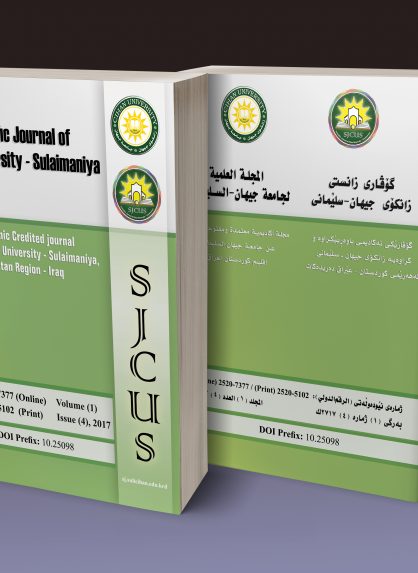| published |
| DOI |
Aras Abdalkarim Amin
Department of English, Cihan University Slemani, Kurdistan Region of Iraq
Received : 29-1-2019 Revised:3-4-2019
Accepted : 22-5-2019 Published :30-6-2019
Abstract
Identifying the pronunciation of the vowel schwa /ə/ within English words, in particular trisyllabic words, seems entirely confusing and difficult because of the fact that there are no explicit phonetic or phonological manifestations which determine where to exactly pronounce this vowel. Consequently, identifying where to pronounce /ə/ within trisyllabic words has been an issue of confusion and overlapping to learners, and, in particular, Kurdish EFL learners. The current paper investigates the improper pronunciation of /ə/ in such words by 30 university learners majoring English as a foreign language. Those learners are instructed to read a list of words which contain 30 trisyllabic words containing the vowel /ə/ in different syllables and are also instructed to transcribe each. The study explicitly demonstrates that Kurdish learners improperly and, to a certain extent, excessively replace this vowel with other vowels whether simple or diphthongs. The improper replacement is mainly the result of specific phonological attributes including the improper estimation of the qualities of the vowels within the syllables of the trisyllabic words and the improper reliance on the spelling and other related attributes.
Keywords: pronunciation, vowel, schwa /ə/, syllable, trisyllabic words, improper pronunciation
پوخته:
ناسینهوه و دهستنیشانكردنی چۆنێتی گۆكردنی ڤاوڵی شوا /ə/ له نێو وشهى ئینگلیزیدا و به تایبهت وشه سێ بڕگهییهكاندا كارێكی قورس و سهرلێشێوێنهره, چونكه هیچ نیشانهیهكی فۆنهتیكی یان فۆنۆلۆژى ئاشكرا نیه بۆ دیاریكردنی چۆنێتی گۆكردنی ئهو ڤاوڵه. بۆیه دهستنیشانكردنی شوێنی گۆكردنی ئهو ڤاوڵه له نێو وشه سێ بڕگهییهكاندا بابهتێكی سهخته و لهگهڵ گرفتی تردا به یهكدا چونی زۆره بهتایبهتیش بۆ خوێندكارانی كورد كه زمانی ئینگلیزی وهك زمانێكی بیانی دهخوێنن. ئهم توێژینهوهیه بهههڵه گۆكردنی ڤاوڵی شوا /ə/ دهخاته بهرباس لهلایهن 30 خوێندكارى زانكۆ كه زمانی ئینگلیزی وهك زمانی بیانی دهخوێنن. ئهم خوێندكارانه ئاڕاسته دهكرێن كه لیستێك وشه بخوێننهوه كه 30 دانه وشهی سێ بڕگهیی له خۆدهگرێت و ههریهكهیان ڤاوڵی شوا-ى تێدایه له شوێنی جیاجیادا و پاشان شێوهى فۆنهتیكیان بۆ بنوسن. توێژینهوهكه بهڕوونی ئهوه دهردهخات كه فێرخوازانی كورد به ههڵه و تا ئهندازهیهكیش به زیادهڕۆیی ئهم ڤاوڵی شوا-یه لادهبهن و ڤاوڵی تر یان دیفسۆنگی له شوێن دادهنێن. ئهم بهههڵه دانان و ئاڵوگۆركردنه به پلهى یهكهم له ئهنجامی ههندێ تایبهتمهندی فۆنۆلۆژییهوه لهوانهش بهههڵه خهمڵاندنی تایبهتمهندی ڤاوڵهكانی نێو بڕگهكانی وشه سێ بڕگهییهكان و به ههڵه پشت بهستن به سپێڵینگ و ههندێ تایبهتمهندی ترهوه.
كلیله وشهكان: گۆكردن, ڤاوڵ, شوا, بڕگه, وشه سێ بڕگهییهكان, ههڵه گۆكردن
الملخص
أن معرفة اللفظ الصحيح لصوت العلة (ə) في كلمات اللغة الانجليزية و على وجة الخصوص في الكلمات ذات المقاطع الثلاث يشكل صعوبة بالغة و ذلك لعدم وجود اثباتات صوتية مخرجية تدل على وجوب تلفظ هذا الصوت. و عليه فان المعرفة الحيثيه لهذا الصوت في الكلمات ذات المقاطع الثلاثة كان احد الصعوبات الصوتية للمتعلمين و بالتحديد للمتعلمين الاكراد الدارسين اللغة الانجليزية لغة اجنبية. يُحقق البحث الحالي في اسباب اللفظ الغير المناسب لهذا الصوت في مثل هذه الكلمات لثلاثين طالبا جامعيا. و تتركز منهجية البحث على اعطاء هؤلاء الطلبة قائمة تتضمن هذه الكلمات التي يتوزع فيها هذا الصوت في كل من المقطع الاول و الثاني و الثالث حيث يتم قراءتها من قبلهم و كذلك فان عليهم كتابة الوصف الصوتي لكل منها. تبين الدراسة ان الطلبة الاكراد لا يستطيعون لفظ هذا الصوت بصورة مناسبة و في بعض الاحيان فانهم يستبدلونه باصوات علة اخرى غير مناسبة. و هذا بسبب عدم ادراكهم بنوعية هذا الصوت المهم و الاعتماد على الاحرف و ليس على الاصوات مما يشكل خللا واضحا في طريقة لفظ هذا الصوت.
الكلمات الرئيسية: التلفظ , صوت العلة, /ə/, المقطع الصوتي, كلمات المقاطع الثلاثة, التلفظ غير المناسب
References
- Almutalabi, M. M. & Ameen, A. A. (2018). Analysing the Improper Pronunciation of Diphthongs by Iraqi EFL learners. JURNAL ARBITRER, 5(1), 17-22. doi: 10.25077/ar.5.1.17-22.2018
- Amer, W. (2012). An Investigation into the Differences between English and Arabic Consonant and Vowel Sounds: A Contrastive Study with Pedagogical Implications. The Islamic University of Gaza: Palestine
- Avery, P. & Ehrlich, S. (1992).Teaching American English pronunciation. Oxford: Oxford
University Press.
- Cleghorn, T.L., & Rugg,N.M. (2011).Comprehensive articulatory phonetics: a tool for mastering the world’s languages. N M Rugg.
- Crystal, D. (2008). A Dictionary of Linguistics and Phonetics. Malden, MA and Oxford: Blackwell Publishing.
- Gerst, A. & Peralejo, C. (2011). Powerful Pronunciation Stress: Schwa Module. The University of British Columbia: English Language Institute, Continuing Studies, UBC.
- Geylanioğlu, S. & Dikilitaş, K. (2011). Pronunciation Errors of Turkish Learners of English Conceptualization Theory as a Teaching Method. The Journal of Language Teaching and Learning, 2(1), 38-50.
- Gilakjani, P. A. (2012). A Study of Factors Affecting EFL Learners’ English Pronunciation Learning and the Strategies for Instruction. International Journal of Humanities and Social Science, 2(3), 119-128.
- Harmer, J. (2001). The Practice of English Language Teaching. London: Longman.
- Kennworthy, J. (1987).Teaching English pronunciation. England: Longman Group UK Limited.
- Ladefoged, P. and Johnson, K. (2010). A course in Phonetics 6th Boston, MA: Thomson-Wadsworth.
- Oxford Advanced Learners Dictionary. (2010). 8th Oxford: Oxford University Press.
- Roach, P. (2009). English Phonetics and Phonology. Cambridge: Cambridge University Press.
- Yates, L. (2002). What is pronunciation?-Adult Migrant English Program (AMEP) Research Centre Fact Sheets, Sydney, National Centre for English Language Teaching and Research, Macquarie University.



